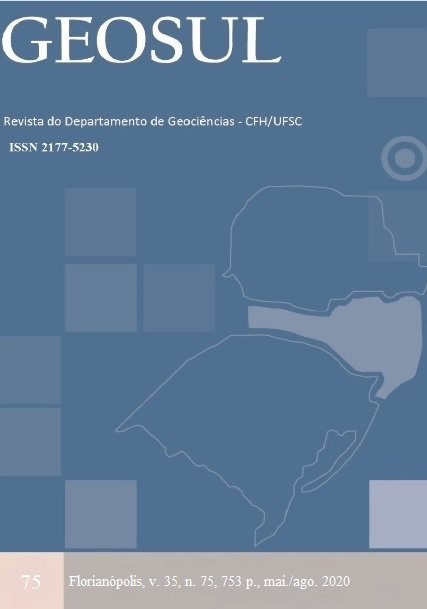Risco de incêndio sazonal em área descampada e de floresta para diferentes cenários climáticos no município de Águas Mornas
DOI:
https://doi.org/10.5007/1982-5153.2020v35n75p580Resumo
O objetivo foi avaliar o risco de incêndio sazonal em área descampada e de floresta, para diferentes cenários climáticos. O local de coleta e estudo de dados foi no município de Águas Mornas, estado de Santa Catarina. Os dados horários foram coletados entre julho de 2017 a fevereiro de 2018, abrangendo as estações inverno, primavera e verão. O risco de incêndio foi determinado pelo Índice de Setzer e Fórmula de Monte Alegre. Observou-se a propensão de queimadas em relação aos cenários futuros, justamente pelo aumento da temperatura. A área descampada apresentou maior ocorrência de incêndio em relação a floresta. Nos cenários climáticos há um aumento no risco ‘médio’, ‘alto’ e ‘muito alto ou crítico’ e uma redução no risco ‘nulo ou mínimo’ e ‘pequeno ou baixo’.Referências
ABREU, L. V. de. Avaliação da escala de influência da vegetação no microclima por diferentes espécies arbóreas. 2008. Dissertação (Mestrado em Engenharia Civil) - Universidade Estadual de Campinas, Campinas, 2008.
ALVARES, C. A. et al. Köppen’s climate classification map for Brazil. Meteorologische Zeitschrift, Stuttgart, v. 22, n. 6, p.711-728, 2013.
ASSUNÇÃO, A. B. D. et al. Utilização da Fórmula de Monte Alegre para identificação de períodos propícios à ocorrência de incêndios na região do vale do Gurgueia. In: CONGRESSO BRASILEIRO DE AGROMETEOROLOGIA, 18. 2013, Belém, PA. Anais [...]. Belém: CBA, 2013. p. 1-6.
BERNARDY, K. et al. Impactos ambientais diante das catástrofes naturais – secas e queimadas. In: SEMINÁRIO INTERINSTITUCIONAL DE ENSINO, PESQUISA E EXTENSÃO, 16., 2011, Cruz Alta. Anais [...]. Cruz Alta: Unicruz, 2011. p. 1-4.
CARVALHO, A. et al. The impact of spatial resolution on area burned and fire occurrence projections in Portugal under climate change. Climatic Change, [s.l.], v. 98, n. 1-2, p.177-197, jan. 2010.
COOK, K.; VIZY, E. K. Effects of Twenty-First Century climate change on the Amazon rain forest. Journal of Climate, v. 21, n. 3, p.542-560, 2008.
DOWDY, A. J. Climatological variability of fire weather in Australia. Journal of Applied Meteorology and Climatology, Boston, v. 57, n. 2, p. 221-234, 2018.
INSTITUTO BRASILEIRO DE GEOGRAFIA E ESTATÍSTICA – IBGE. Indicadores de desenvolvimento Sustentável. Rio de Janeiro: IBGE, 2015. 352 p.
INTERGOVERNMENTAL PANEL ON CLIMATE CHANGE – IPCC. Climate change 2013: The Physical Science Basis. Contribution of Working Group I to the Fifth Assessment Report of the Intergovernmental Panel on Climate Change. Genebra: IPCC, 2013.
MARTINI, A.; BIONDI, D. Microclima e conforto térmico de um fragmento de floresta urbana em Curitiba, PR. Floresta e Ambiente, Rio de Janeiro, v. 22, n. 2, p.182-193, 2015.
MÉLO, A. S. de. Suscetibilidade do ambiente a ocorrência de queimadas sob condições climáticas atuais e de aquecimento global. 2009. Dissertação (Mestrado em Meteorologia Agrícola) - Universidade Federal de Viçosa, Viçosa, 2009.
MELO, A. S. de et al. Índices de risco de fogo de Haines e Setzer em diferentes condições climáticas. Mercator, v. 11, n. 24, p.187-207, 2012.
MBANZE, A. A. et al. Influence of the meteorological conditions on forest fires occurrences in Lichinga District, Northern Mozambique. Floresta, Curitiba, v. 45, n. 3, p. 577-586, mar. 2015.
PAINEL BRASILEIRO DE MUDANÇAS CLIMÁTICAS – PBMC. Base científica das mudanças climáticas: primeiro relatório de avaliação nacional. Rio de Janeiro: PBMC, 2014. 392p.
SETZER, A. et al. O uso de satélites NOAA na detecção de queimadas no Brasil. Climanálise, v. 7, n 8, p. 40-53, 2002.
SOARES, R. V. Índices de perigo de incêndio. Floresta, Curitiba, v. 3, n. 3, p. 19-40, 1972.
TEIXEIRA, N. C. et al. Análise preliminar da relação entre queimadas e chuvas no estado de Santa Catarina. In: SIMPÓSIO BRASILEIRO DE RECURSOS HÍDRICOS, 22., 2017, Florianópolis, SC. Anais [...]. Florianópolis: SBRH, 2017. p. 1-8.
TORRES, F. T. P. et al. Perfil dos incêndios florestais em unidades de conservação brasileiras no período de 2008 a 2012. Floresta, Curitiba, v. 46, n. 4, p. 531-542, ago. 2016.
WEATHERLY, J. W.; ROSENBAUM, M. A. Future projections of heat and fire-risk indices for the contiguous United States. Journal of Applied Meteorology and Climatology, Boston, v. 56, n. 4, p.863-876, 2017.
WORLD METEOROLOGICAL ORGANIZATION – WMO. Weather and climate forecasts for agriculture. [S.l.]: WMO., 2012. 790p.
Downloads
Publicado
Edição
Seção
Licença

Este trabalho está licenciado com uma Licença Creative Commons - Atribuição 4.0 Internacional.





